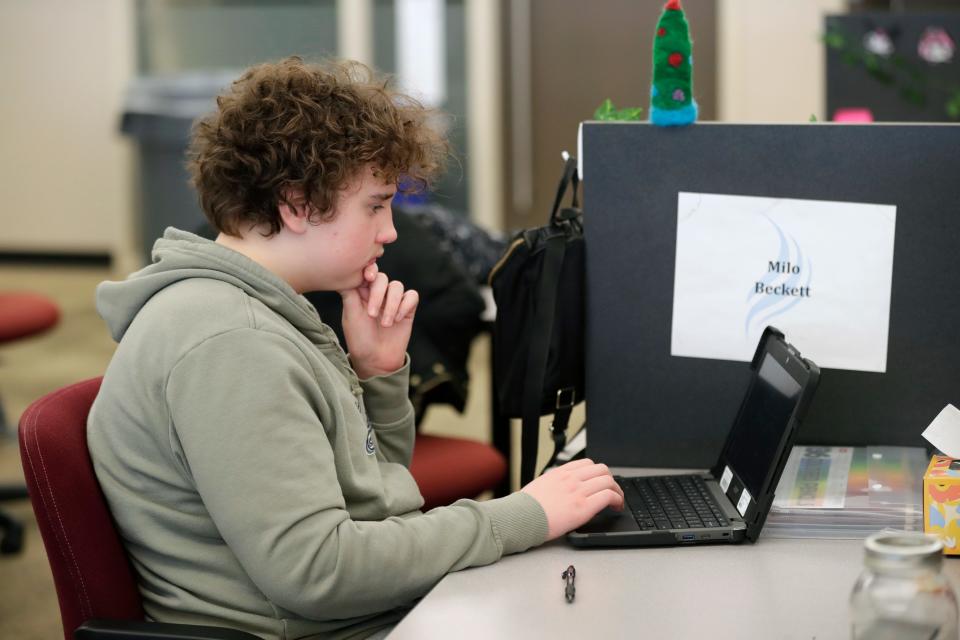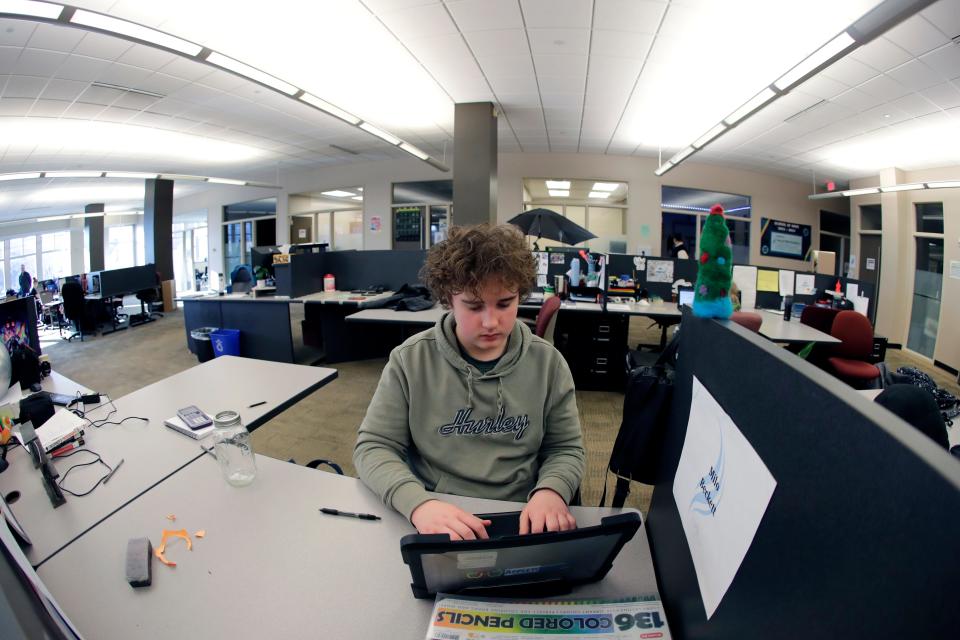As schools grapple with artificial intelligence, this Appleton school is teaching students how to use it responsibly
APPLETON — While some school districts in Wisconsin have artificial intelligence programs like ChatGPT blocked on school Wi-Fi, Appleton's Valley New School is embracing them.
The charter school, which serves grades seven through 12, is spending the entire school year investigating AI in education — allowing students to use it for their assignments and teaching them about using it ethically.
Thanks to a grant from the Appleton Education Foundation, the school was able to buy AI programs and host workshops with their students and staff exploring how AI works, including its numerous uses and limitations.
AI teaches students how to fact check and seek credible sources for information
About 13% of all U.S. teens ages 13 to 17 have used the AI program ChatGPT to do their school work, according to a 2023 Pew Research survey. When looking solely at students who are familiar with the software, that number jumps to about one in five students.
In general, there are concerns in education that as AI evolves and becomes more accessible, students will use it to cheat on assignments, particularly with math problems and essays.

"Our hope is that they would come to use AI as a tool rather than a way to cheat or circumvent their learning," said Burke Wallace, a teacher at Valley New School. "That's been a big focus for us."
Some students have used AI to completely do their assignments for them. But Wallace said that those cases have been very obvious. Part of the grant is used to teach educators and staff about using AI and how to detect it.
More: Last year, no Appleton public school failed to meet educational expectations. This year, two did.
Programs like ChatGPT, which is the main program the school is using, work by typing in a prompt, and then the program scours the internet to answer the prompt to the best of its ability.
For example, a 10th-grade student could type a prompt asking ChatGPT to write a 750-word essay about "The Great Gatsby," focusing on the historical backdrop of the story. But ChatGPT doesn’t know to write the essay at a 10th-grade level, unless it’s told to.
Wallace said that in the cases where students relied solely on AI to do their work, what they turned in was often at a higher caliber than the students were capable of.
Students themselves are finding that AI programs like ChatGPT are sometimes more work to use and require strict fact checking.
Sage, a sophomore at Valley New School, said they don’t like using AI for a lot of their assignments because sometimes it uses sources that aren’t high quality. It can be more work to use AI and fact check its sources than doing the research yourself, Sage found.

“(The sources are) just the most viewed ones or the most looked at ones,” they said. “It's not necessarily credible, but you have to look at the authors. You have to make sure the authors are real.”
Senior Caitlyn Bryan used AI to help create an analysis guide for a book she was reading in class. Despite having the help of AI, she still had to fact check everything the program created to make sure it was correct.
“If you do use it to make like (assignments) or whatever, then you have to add something about fact checking it … just to make it more legitimate,” she said.
That's a key point Wallace wants his students to consider: What is AI telling them? Is it true?
"They need to compare that to the research that they've done on their own," he said. "It's another opportunity for students to critically think and to not just be blanket consumers."
Students use AI to learn foreign languages and help with brainstorming ideas
Bryan has been using AI to learn Norwegian since the school doesn’t have a Norwegian language teacher. She’s used ChatGPT as a penpal to practice writing in the language, or she’ll ask it to come up with a story for her to learn new vocabulary.
Yet, AI isn’t perfect, and Bryan finds herself having to correct ChatGPT.
“I found out through trying to use ChatGPT as a I guess a way to learn how to read different words and learn new words and stuff like that, that it's not good at teaching grammar rules for foreign languages,” she said.
The pen pal idea is something Valley New School is hoping to adopt for other students so they can practice reading, writing and learning new words in a foreign language.
Students aren't just learning about text-based AI. They're also learning about AI image generators.
Sage has used the AI image generating software Midjourney to help brainstorm concepts for a book they’re writing. They’ll give the software prompts for characters or scenes, and it will create images to help them visualize their story.
Bryan also said AI can help students understand complex texts or research articles that may be above their reading level. Students can drop a paragraph into ChatGPT and have it summarize the information or break it down to a lower reading level.
More: New Appleton charter school focused on African culture and history opens next fall
While the students recognize it’s a useful tool, not all of them like relying on it.
“The reason I don't like using AI in everything in my project is because I want to feel like I did something that came from my mind,” Sage said.
A key part of the school’s AI instruction is ensuring the students understand how to use AI properly because the technology is here to stay, according to Wallace.
“AI is an emerging technology that's not going away. It's only going to get bigger,” Wallace said. “We want to make sure that our students know how to use it responsibly and ethically.”
Danielle DuClos is a Report for America corps member who covers K-12 education for the Green Bay Press-Gazette. Contact her at dduclos@gannett.com. Follow on Twitter @danielle_duclos. You can directly support her work with a tax-deductible donation at GreenBayPressGazette.com/RFA or by check made out to The GroundTruth Project with subject line Report for America Green Bay Press Gazette Campaign. Address: The GroundTruth Project, Lockbox Services, 9450 SW Gemini Drive, PMB 46837, Beaverton, Oregon 97008-7105.
This article originally appeared on Green Bay Press-Gazette: Valley New School embraces AI, teaching how to use it responsibly

